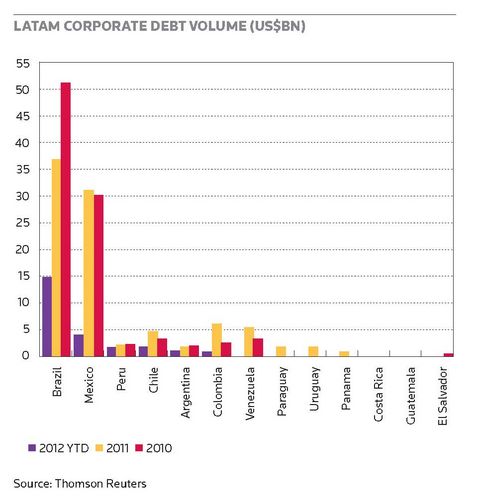Latin America is seeing a record volume of corporate bond issuance in the international markets, as the syndicated loans market dries up and companies need to find another way of financing their acquisition sprees.
Merger and acquisition activity in Latin America got off to a very strong start this year with debt bankers enjoying the benefits with corporate shopping helping to drive record levels of corporate bond issuance.
By February 8, year-to-date total M&A activity amounted to US$29.856bn from 158 separate deals, according to Thomson Reuters. Most of the activity is from Brazil, with a total volume of US$23.71bn (62 deals), followed by Chile with US$5.15bn (29 deals) and Costa Rica with US$801m (three deals).
The acceleration in issuance is also expected to continue across countries and sectors in LatAm and into other regions.
“We are expecting this to be a very strong year again for M&A activity in the region,” says Udi Marguiles, head of LatAm M&A at Barclays Capital. “There is a lot of cross-Europe and cross-Asia transaction flow out of LatAm. The mining and oil and gas sectors in particular are very buoyant. There is a great deal of international interest in the region’s commodity or natural resource assets. We are also seeing Latin American groups acquire in Europe and the US. Throughout LatAm we are seeing consolidation in the consumer, retail, food and beverage, and banking markets but it’s true that most of the activity is coming out of Brazil. We expect to see a pick-up in the volume of deals out of Mexico.”
A record amount of bond issuance by Latin American corporates accompanied the deal flow with total issuance of US$23.3bn (29 deals) by February 15.
Brazil’s corporates have been the biggest issuers in the international markets this year, with 15 deals valued at US$14.77bn, followed by Mexican companies with five transactions valued at US$3.86bn.
“M&A activity throughout Latin America has accelerated sharply during the past two years,” says Christopher Gilfond, co-head of LatAm credit markets at Citi. “I think it’s fair to say that we have started to see a lot more outbound M&A activity from the region than inbound. I would say two-thirds of deals these days are outbound, one-third inbound. It’s becoming common for a Latin American group to make a purchase in the US or Europe, where corporate valuations tend to be lower today.”
Mario Espinosa, co-head of LatAm credit markets at Citigroup, adds: “Many acquisitions are of a strategic nature and, at least at first, some portion of the acquisition financing is likely to come from bridging loans. The acquirer will have in place debt covenants with its principal bankers. However, within a relatively short period of up to 18 months, it will want to have in place permanent lending, which could involve a syndication or a bond issued in the domestic or international markets.”
“It’s becoming common for a Latin American group to make a purchase in the US or Europe, where corporate valuations tend to be lower today”
Last year, total M&A activity in the region added up by US$147.88bn (1,904 deals) against US$193.68bn (1,771 transactions) in 2010. Brazilian companies were the biggest issuers of debt internationally, surpassing US$32.7bn (45 deals), followed by Mexican corporates with US$15.13bn (24 deals). Peruvian firms were ranked number three for international DCM activity last year, with a total deal volume of US$1.7bn (five deals).
Setting a trend
Bimbo, the Mexican bakery group, is a prime example of a company breaking out of the region with acquisitions that are quickly refinanced through debt markets. In November 2011, Bimbo completed the purchase of the North American fresh bakery of Sara Lee, the global consumer-goods company, for US$709m. A month earlier Bimbo also announced plans to acquire Sara Lee’s fresh bakery businesses in Spain and Portugal for €115m (US$158.3m).
In April, the Mexican group took out a five-year syndicated loan for US$1.3bn from 10 financial institutions, to refinance existing debt on better terms as well as to fund partially the Sara Lee deal (Bimbo originally announced the deal in November 2010 but it took one year for the US regulatory authorities and courts to give it the all clear). The loan had an interest rate of Libor, plus 110bp. Banks that participated in the syndicate included Bank of America, Bank of Tokyo-Mitsubishi, BBVA Bancomer, Citigroup, HSBC, ING, Santander, JP Morgan, Mizuho Corporate Bank and Barclays.
Bimbo – an investment-grade company – quickly followed the completion of the acquisitions with a bond issue. On January 18 this year, it issued a 10-year, US$800m bond with a coupon of 4.5%. It yields 4.602% and BBVA, Citigroup, and Santander arranged the deal.
“It makes sense for a corporate to quickly move from financing an acquisition from a bridging loan to issuing a bond, especially if the return on capital of the purchase is over a relatively long period,” adds Espinosa. “The cost of capital in the bond markets is also relatively low.”
European and US exits
Bankers say Mexican companies are finding it harder to access the loans market because many European and US banks – which previously had been active lenders – have retrenched and now have tighter liquidity because of Basel III requirements. Most of Mexico’s big banks, such as Banamex (part of Citi) and Bancomer (part of BBVA) have foreign ownership. However, strong Mexican names – especially investment-grade ones – are finding it easy to tap the bond markets.
On the other hand, Brazil’s biggest banks – such as Itau Unibanco and Bradesco – are homegrown, with even Santander Brasil run pretty much independently from its Spanish parents. These banks are highly liquid in Brazilian Reais terms and are happy to provide acquisition financing in the form of loans for deals that take place within the country. However, they are much less likely to finance a cross-border acquisition that entails a purchase in dollars because the bank’s own cost of borrowing in dollars is very high. Brazilian acquirers of overseas companies have to tap the bond market.
Many LatAm companies are well capitalised and use cash on hand or existing bank lines to fund acquisitions. Those that need acquisition financing get it in the form of a bridge loan from their banks. More often than not, those banks are also the underwriters that sell the bonds or shares that refinance the bridge loan. Many acquisitions are bridged. The banks providing the bridge are also mandated on the takeout.
Highly rated LatAm corporates have no problem in issuing in international markets, as today foreign investors feel many have a lower risk profile than their counterparts in Europe or the US. However, some LatAm countries – notably Chile, Mexico, Brazil – have very strong domestic DCM markets and it is also relatively easy for companies from those countries to call upon their domestic markets. Colombia and Peru also have rapidly developing domestic bond markets.
“We are seeing a lot of activity from the Southern Cone, the Andean region, Brazil and Mexico,” says Roberto D’Avola, head of Latin American DCM at JP Morgan. “This year has so far started off very strong, with numerous deals. There also seems to be relatively high expectations to lower all-in yields given the low base rates and a reduction of spreads.”
Gustavo Ferraro, head of LatAm DCM at Barclays Capital, continues: “Latin American companies tend to be very conservative in their approach to financing. They are often able to secure longer-dated term loans with attractive terms from their relationship banks, which give them even greater flexibility to finance an acquisition than a standard 364-day bridge loan.”
“How quickly an acquirer issues a bond depends on the company – they do not want to rush, they only want to tap the bond market when there is a clear window,” he adds. For example, in December 2010 Banco de Bogota purchased BAC-Credomatic – a banking group with operations in Costa Rica, El Salvador, Guatemala, Honduras, Nicaragua and Panama – from GE for US$1.92bn.
Initially, 75% shareholder Groupo Aval financed US$1.3bn from its own resources and the rest from bank loans. However, in December 2011, Banco de Bogota issued US$600m five-year bonds in the international markets, in part to refinance the acquisition loans. It sold the 5%, dollar-denominated paper to yield 5.25%. Initially it planned to sell US$500m of bonds but upped the sum, as investor demand totalled more than US$3.2bn. Citigroup, HSBC and JP Morgan Chase managed the sale.
The delay was judicious as in the intervening period Colombia’s credit rating was raised to investment grade by both Moody’s and Standard & Poor’s. Colombian banks benefited from the rating change by being able to issue debt under better terms, encouraging them to continue shopping..
“Colombians have been aggressive bidders,” says Jim Allen, head of LatAm M&A at Morgan Stanley. “They have put financing in place and gone ahead and completed deals.”
GrupoSura, a Colombian holding company, beat out several other bidders from Latin America and the US to purchase ING’s LatAm pension assets for US$3.9bn in 2011. In January, Davivienda, a Colombian bank, announced a deal to acquire HSBC’s banking operations in LatAm for US$800m.
To view the digital version of this report, please click here.


